Knowledge Management: Case Study Analysis and Strategies
VerifiedAdded on 2022/11/24
|12
|2734
|332
Case Study
AI Summary
This case study examines the effects of knowledge management (KM) strategies on organizational performance, drawing from a study of 131 Korean firms. The research explores the relationship between KM and organizational perspectives, focusing on knowledge sharing. The study investigates the interplay of explicit and tacit knowledge, internal and external strategies, and their impact on performance. The analysis employs clustering, association, and complementarity analysis to assess the relationships between KM strategies and organizational outcomes. Findings reveal that the integration of explicit and tacit knowledge may not always lead to higher performance, while external or internal-oriented strategies can be beneficial. Combining tacit-internal and explicit-external strategies demonstrates a complementary relationship, suggesting synergistic effects. The research highlights the importance of knowledge sharing and its impact on organizational success. The study also acknowledges limitations, such as the exclusion of small-scale companies, and emphasizes the significance of KM in driving organizational performance.
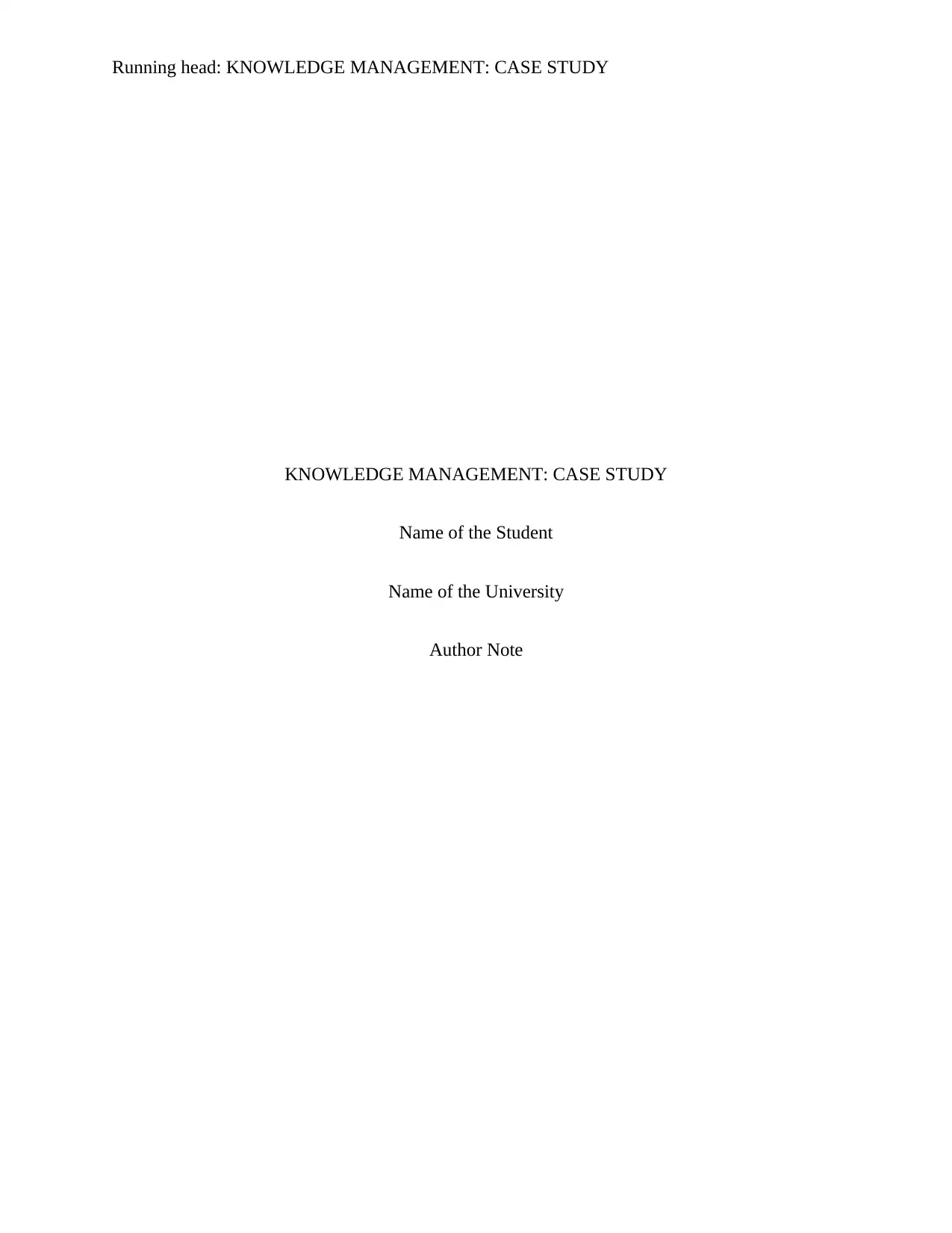
Running head: KNOWLEDGE MANAGEMENT: CASE STUDY
KNOWLEDGE MANAGEMENT: CASE STUDY
Name of the Student
Name of the University
Author Note
KNOWLEDGE MANAGEMENT: CASE STUDY
Name of the Student
Name of the University
Author Note
Paraphrase This Document
Need a fresh take? Get an instant paraphrase of this document with our AI Paraphraser
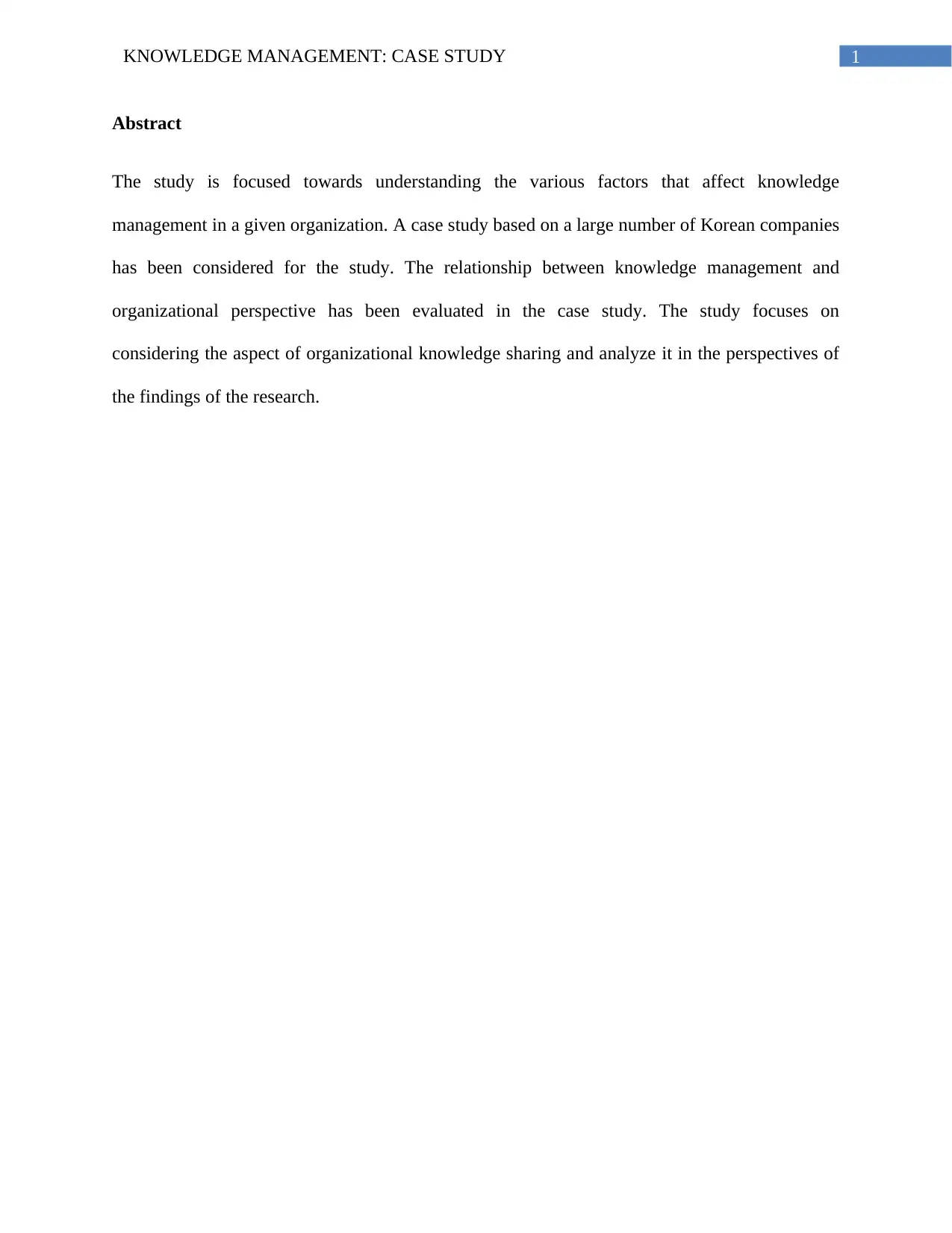
1KNOWLEDGE MANAGEMENT: CASE STUDY
Abstract
The study is focused towards understanding the various factors that affect knowledge
management in a given organization. A case study based on a large number of Korean companies
has been considered for the study. The relationship between knowledge management and
organizational perspective has been evaluated in the case study. The study focuses on
considering the aspect of organizational knowledge sharing and analyze it in the perspectives of
the findings of the research.
Abstract
The study is focused towards understanding the various factors that affect knowledge
management in a given organization. A case study based on a large number of Korean companies
has been considered for the study. The relationship between knowledge management and
organizational perspective has been evaluated in the case study. The study focuses on
considering the aspect of organizational knowledge sharing and analyze it in the perspectives of
the findings of the research.
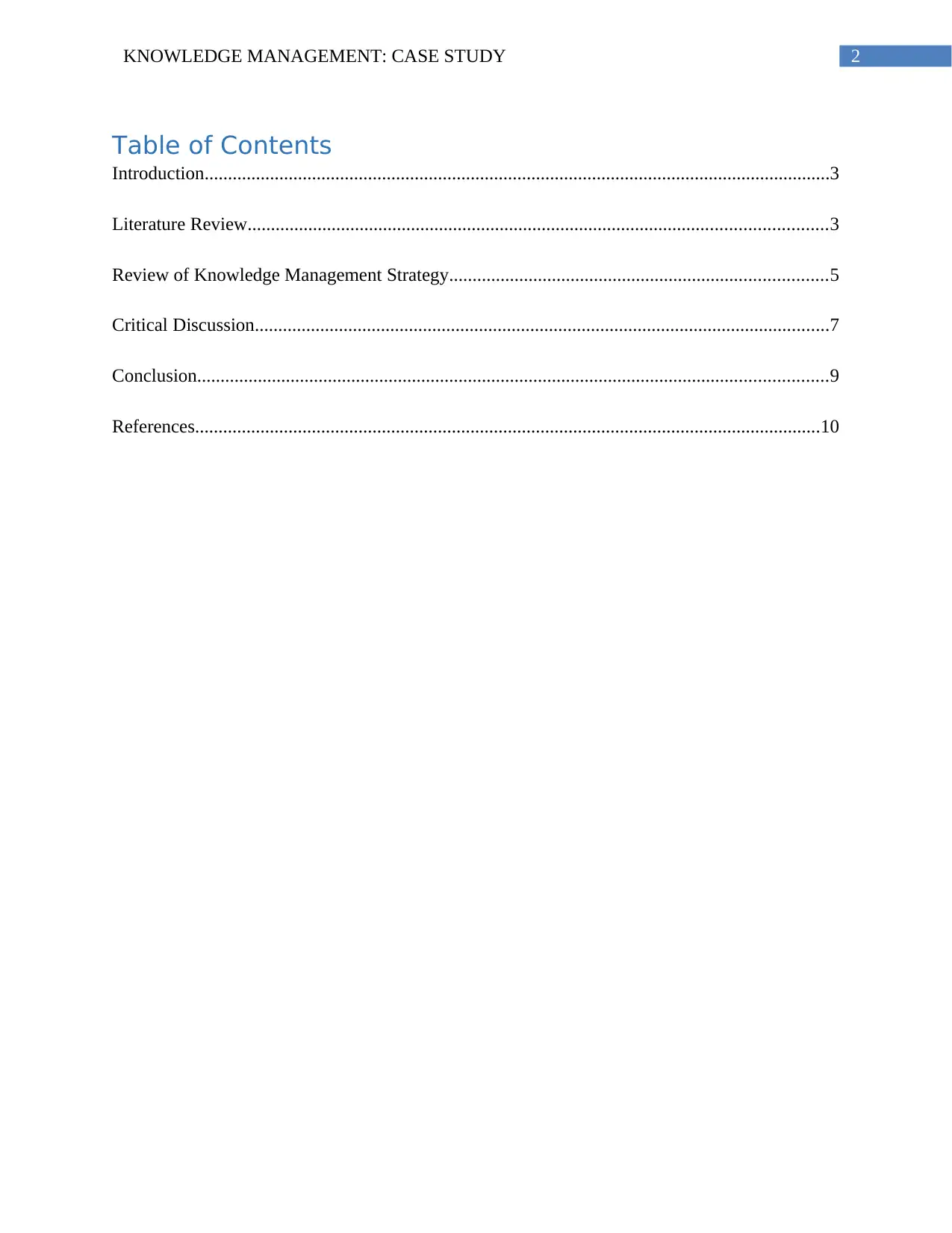
2KNOWLEDGE MANAGEMENT: CASE STUDY
Table of Contents
Introduction......................................................................................................................................3
Literature Review............................................................................................................................3
Review of Knowledge Management Strategy.................................................................................5
Critical Discussion...........................................................................................................................7
Conclusion.......................................................................................................................................9
References......................................................................................................................................10
Table of Contents
Introduction......................................................................................................................................3
Literature Review............................................................................................................................3
Review of Knowledge Management Strategy.................................................................................5
Critical Discussion...........................................................................................................................7
Conclusion.......................................................................................................................................9
References......................................................................................................................................10
⊘ This is a preview!⊘
Do you want full access?
Subscribe today to unlock all pages.

Trusted by 1+ million students worldwide
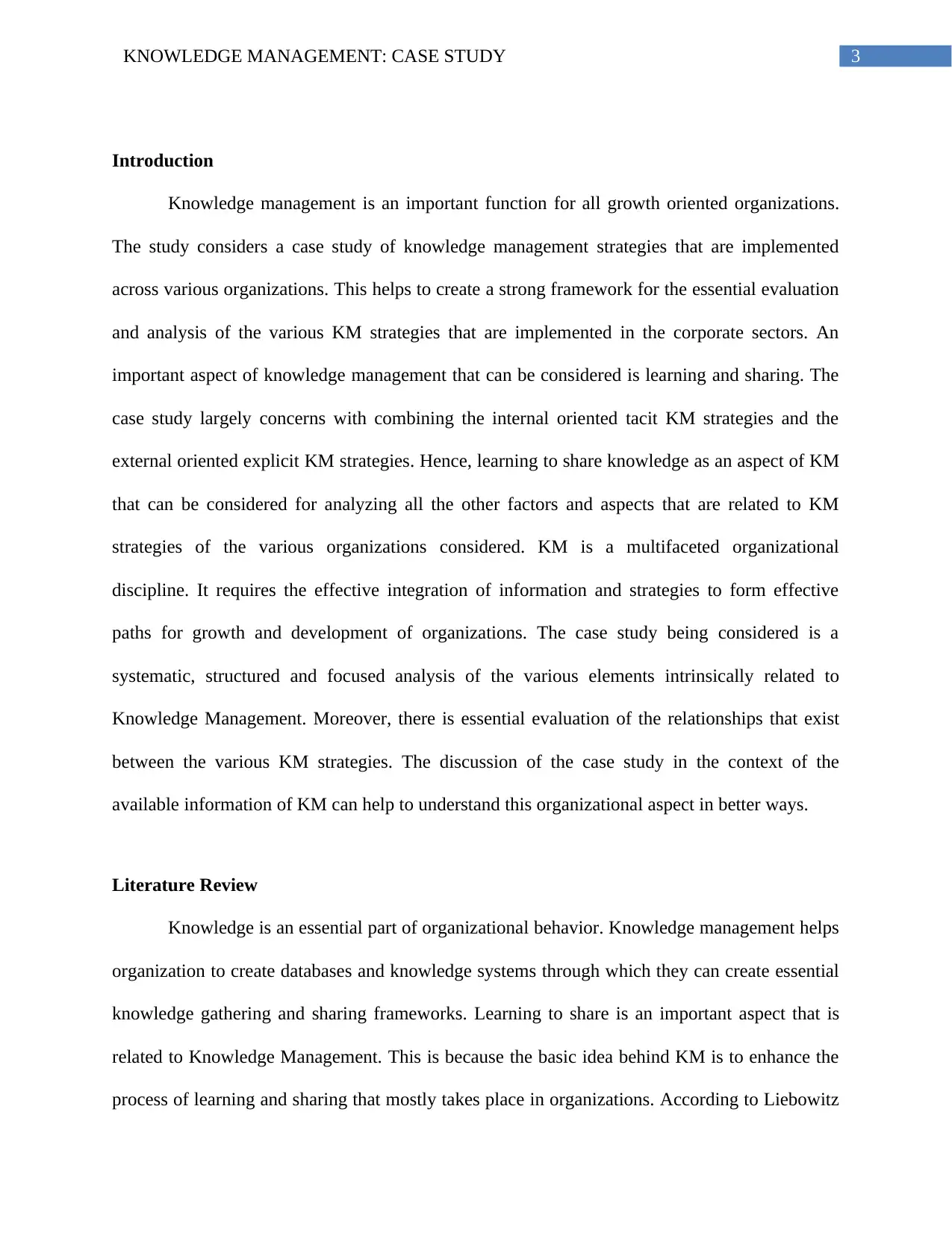
3KNOWLEDGE MANAGEMENT: CASE STUDY
Introduction
Knowledge management is an important function for all growth oriented organizations.
The study considers a case study of knowledge management strategies that are implemented
across various organizations. This helps to create a strong framework for the essential evaluation
and analysis of the various KM strategies that are implemented in the corporate sectors. An
important aspect of knowledge management that can be considered is learning and sharing. The
case study largely concerns with combining the internal oriented tacit KM strategies and the
external oriented explicit KM strategies. Hence, learning to share knowledge as an aspect of KM
that can be considered for analyzing all the other factors and aspects that are related to KM
strategies of the various organizations considered. KM is a multifaceted organizational
discipline. It requires the effective integration of information and strategies to form effective
paths for growth and development of organizations. The case study being considered is a
systematic, structured and focused analysis of the various elements intrinsically related to
Knowledge Management. Moreover, there is essential evaluation of the relationships that exist
between the various KM strategies. The discussion of the case study in the context of the
available information of KM can help to understand this organizational aspect in better ways.
Literature Review
Knowledge is an essential part of organizational behavior. Knowledge management helps
organization to create databases and knowledge systems through which they can create essential
knowledge gathering and sharing frameworks. Learning to share is an important aspect that is
related to Knowledge Management. This is because the basic idea behind KM is to enhance the
process of learning and sharing that mostly takes place in organizations. According to Liebowitz
Introduction
Knowledge management is an important function for all growth oriented organizations.
The study considers a case study of knowledge management strategies that are implemented
across various organizations. This helps to create a strong framework for the essential evaluation
and analysis of the various KM strategies that are implemented in the corporate sectors. An
important aspect of knowledge management that can be considered is learning and sharing. The
case study largely concerns with combining the internal oriented tacit KM strategies and the
external oriented explicit KM strategies. Hence, learning to share knowledge as an aspect of KM
that can be considered for analyzing all the other factors and aspects that are related to KM
strategies of the various organizations considered. KM is a multifaceted organizational
discipline. It requires the effective integration of information and strategies to form effective
paths for growth and development of organizations. The case study being considered is a
systematic, structured and focused analysis of the various elements intrinsically related to
Knowledge Management. Moreover, there is essential evaluation of the relationships that exist
between the various KM strategies. The discussion of the case study in the context of the
available information of KM can help to understand this organizational aspect in better ways.
Literature Review
Knowledge is an essential part of organizational behavior. Knowledge management helps
organization to create databases and knowledge systems through which they can create essential
knowledge gathering and sharing frameworks. Learning to share is an important aspect that is
related to Knowledge Management. This is because the basic idea behind KM is to enhance the
process of learning and sharing that mostly takes place in organizations. According to Liebowitz
Paraphrase This Document
Need a fresh take? Get an instant paraphrase of this document with our AI Paraphraser
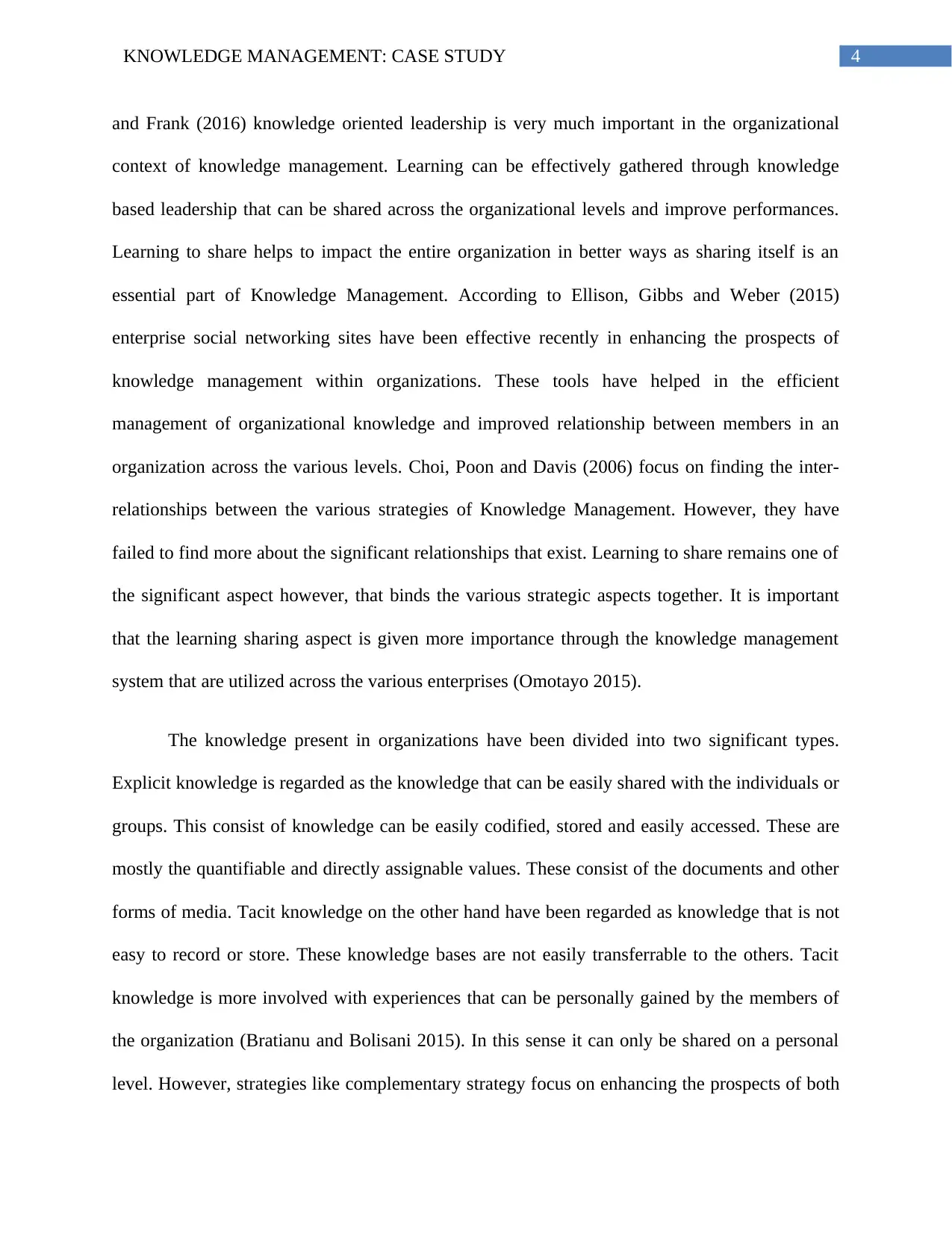
4KNOWLEDGE MANAGEMENT: CASE STUDY
and Frank (2016) knowledge oriented leadership is very much important in the organizational
context of knowledge management. Learning can be effectively gathered through knowledge
based leadership that can be shared across the organizational levels and improve performances.
Learning to share helps to impact the entire organization in better ways as sharing itself is an
essential part of Knowledge Management. According to Ellison, Gibbs and Weber (2015)
enterprise social networking sites have been effective recently in enhancing the prospects of
knowledge management within organizations. These tools have helped in the efficient
management of organizational knowledge and improved relationship between members in an
organization across the various levels. Choi, Poon and Davis (2006) focus on finding the inter-
relationships between the various strategies of Knowledge Management. However, they have
failed to find more about the significant relationships that exist. Learning to share remains one of
the significant aspect however, that binds the various strategic aspects together. It is important
that the learning sharing aspect is given more importance through the knowledge management
system that are utilized across the various enterprises (Omotayo 2015).
The knowledge present in organizations have been divided into two significant types.
Explicit knowledge is regarded as the knowledge that can be easily shared with the individuals or
groups. This consist of knowledge can be easily codified, stored and easily accessed. These are
mostly the quantifiable and directly assignable values. These consist of the documents and other
forms of media. Tacit knowledge on the other hand have been regarded as knowledge that is not
easy to record or store. These knowledge bases are not easily transferrable to the others. Tacit
knowledge is more involved with experiences that can be personally gained by the members of
the organization (Bratianu and Bolisani 2015). In this sense it can only be shared on a personal
level. However, strategies like complementary strategy focus on enhancing the prospects of both
and Frank (2016) knowledge oriented leadership is very much important in the organizational
context of knowledge management. Learning can be effectively gathered through knowledge
based leadership that can be shared across the organizational levels and improve performances.
Learning to share helps to impact the entire organization in better ways as sharing itself is an
essential part of Knowledge Management. According to Ellison, Gibbs and Weber (2015)
enterprise social networking sites have been effective recently in enhancing the prospects of
knowledge management within organizations. These tools have helped in the efficient
management of organizational knowledge and improved relationship between members in an
organization across the various levels. Choi, Poon and Davis (2006) focus on finding the inter-
relationships between the various strategies of Knowledge Management. However, they have
failed to find more about the significant relationships that exist. Learning to share remains one of
the significant aspect however, that binds the various strategic aspects together. It is important
that the learning sharing aspect is given more importance through the knowledge management
system that are utilized across the various enterprises (Omotayo 2015).
The knowledge present in organizations have been divided into two significant types.
Explicit knowledge is regarded as the knowledge that can be easily shared with the individuals or
groups. This consist of knowledge can be easily codified, stored and easily accessed. These are
mostly the quantifiable and directly assignable values. These consist of the documents and other
forms of media. Tacit knowledge on the other hand have been regarded as knowledge that is not
easy to record or store. These knowledge bases are not easily transferrable to the others. Tacit
knowledge is more involved with experiences that can be personally gained by the members of
the organization (Bratianu and Bolisani 2015). In this sense it can only be shared on a personal
level. However, strategies like complementary strategy focus on enhancing the prospects of both
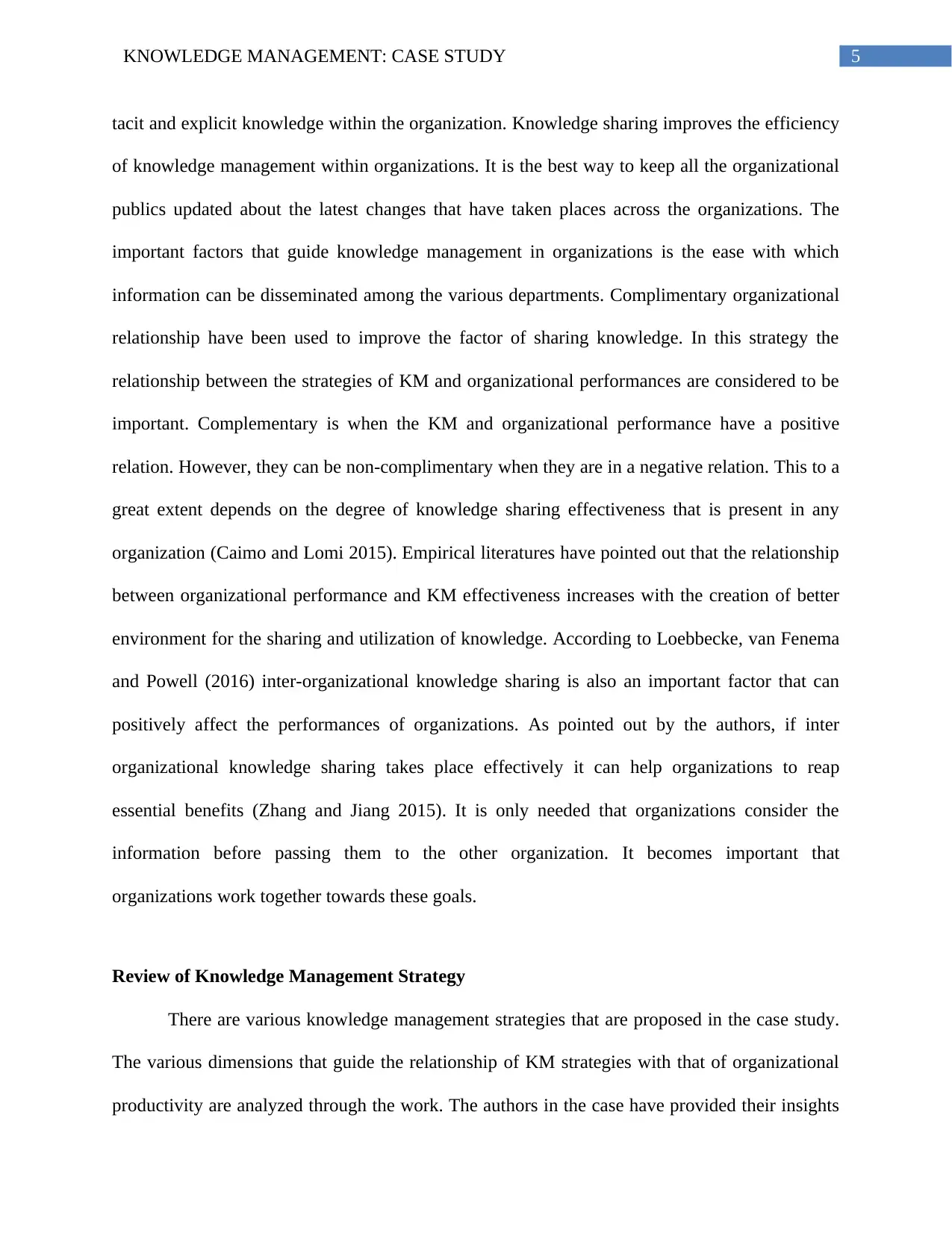
5KNOWLEDGE MANAGEMENT: CASE STUDY
tacit and explicit knowledge within the organization. Knowledge sharing improves the efficiency
of knowledge management within organizations. It is the best way to keep all the organizational
publics updated about the latest changes that have taken places across the organizations. The
important factors that guide knowledge management in organizations is the ease with which
information can be disseminated among the various departments. Complimentary organizational
relationship have been used to improve the factor of sharing knowledge. In this strategy the
relationship between the strategies of KM and organizational performances are considered to be
important. Complementary is when the KM and organizational performance have a positive
relation. However, they can be non-complimentary when they are in a negative relation. This to a
great extent depends on the degree of knowledge sharing effectiveness that is present in any
organization (Caimo and Lomi 2015). Empirical literatures have pointed out that the relationship
between organizational performance and KM effectiveness increases with the creation of better
environment for the sharing and utilization of knowledge. According to Loebbecke, van Fenema
and Powell (2016) inter-organizational knowledge sharing is also an important factor that can
positively affect the performances of organizations. As pointed out by the authors, if inter
organizational knowledge sharing takes place effectively it can help organizations to reap
essential benefits (Zhang and Jiang 2015). It is only needed that organizations consider the
information before passing them to the other organization. It becomes important that
organizations work together towards these goals.
Review of Knowledge Management Strategy
There are various knowledge management strategies that are proposed in the case study.
The various dimensions that guide the relationship of KM strategies with that of organizational
productivity are analyzed through the work. The authors in the case have provided their insights
tacit and explicit knowledge within the organization. Knowledge sharing improves the efficiency
of knowledge management within organizations. It is the best way to keep all the organizational
publics updated about the latest changes that have taken places across the organizations. The
important factors that guide knowledge management in organizations is the ease with which
information can be disseminated among the various departments. Complimentary organizational
relationship have been used to improve the factor of sharing knowledge. In this strategy the
relationship between the strategies of KM and organizational performances are considered to be
important. Complementary is when the KM and organizational performance have a positive
relation. However, they can be non-complimentary when they are in a negative relation. This to a
great extent depends on the degree of knowledge sharing effectiveness that is present in any
organization (Caimo and Lomi 2015). Empirical literatures have pointed out that the relationship
between organizational performance and KM effectiveness increases with the creation of better
environment for the sharing and utilization of knowledge. According to Loebbecke, van Fenema
and Powell (2016) inter-organizational knowledge sharing is also an important factor that can
positively affect the performances of organizations. As pointed out by the authors, if inter
organizational knowledge sharing takes place effectively it can help organizations to reap
essential benefits (Zhang and Jiang 2015). It is only needed that organizations consider the
information before passing them to the other organization. It becomes important that
organizations work together towards these goals.
Review of Knowledge Management Strategy
There are various knowledge management strategies that are proposed in the case study.
The various dimensions that guide the relationship of KM strategies with that of organizational
productivity are analyzed through the work. The authors in the case have provided their insights
⊘ This is a preview!⊘
Do you want full access?
Subscribe today to unlock all pages.

Trusted by 1+ million students worldwide

6KNOWLEDGE MANAGEMENT: CASE STUDY
into the various relationships that are established between KM strategies and organizational
performances. This has created an essential understanding of the subject matter as knowledge
management has been evaluated from various essential perspectives. The data for the analysis
had been gathered from 131 listed Korean companies. The study has focused on gathering
essential information about the companies and the KM techniques and strategies that have been
utilized in these companies through survey questionnaires that were distributed amongst the
members of the organization. The data was also gathered from the corporation reports. This gives
a perspective that the data that were gathered were captured from authentic sources. Moreover,
this data gave way to developing better understanding of the subject matter. The relevance of the
study towards analyzing the Knowledge management systems across the various organizations
can be made certain due to the same. The Likert scale was used to measure the opinions that
helped to provide a significant outlook in terms of the value of the research. The paper has aimed
to understand why the previous literatures have been unable to investigate properly the
relationship between the knowledge management strategies and the performances of the
organizations. The various relationships that have been explored are the complimentary, non-
complimentary, symmetric and asymmetric relationship. It is important to note that along with
the same the study has also focused towards analyzing the tacit and explicit KM strategies that
are prevalent across the various organization (Choi, Poon and Davis 2008).
The analysis has been the most important part of the research that has taken place. Firstly,
the strategy classification has been done. The study in this case much essentially found essential
information by utilizing the three types of analysis. They are the clustering analysis, association
analysis and the complimentary analysis. Secondly, the relationship assessment has been done
drawing upon the implications that have been derived from the first stage of the analysis process.
into the various relationships that are established between KM strategies and organizational
performances. This has created an essential understanding of the subject matter as knowledge
management has been evaluated from various essential perspectives. The data for the analysis
had been gathered from 131 listed Korean companies. The study has focused on gathering
essential information about the companies and the KM techniques and strategies that have been
utilized in these companies through survey questionnaires that were distributed amongst the
members of the organization. The data was also gathered from the corporation reports. This gives
a perspective that the data that were gathered were captured from authentic sources. Moreover,
this data gave way to developing better understanding of the subject matter. The relevance of the
study towards analyzing the Knowledge management systems across the various organizations
can be made certain due to the same. The Likert scale was used to measure the opinions that
helped to provide a significant outlook in terms of the value of the research. The paper has aimed
to understand why the previous literatures have been unable to investigate properly the
relationship between the knowledge management strategies and the performances of the
organizations. The various relationships that have been explored are the complimentary, non-
complimentary, symmetric and asymmetric relationship. It is important to note that along with
the same the study has also focused towards analyzing the tacit and explicit KM strategies that
are prevalent across the various organization (Choi, Poon and Davis 2008).
The analysis has been the most important part of the research that has taken place. Firstly,
the strategy classification has been done. The study in this case much essentially found essential
information by utilizing the three types of analysis. They are the clustering analysis, association
analysis and the complimentary analysis. Secondly, the relationship assessment has been done
drawing upon the implications that have been derived from the first stage of the analysis process.
Paraphrase This Document
Need a fresh take? Get an instant paraphrase of this document with our AI Paraphraser
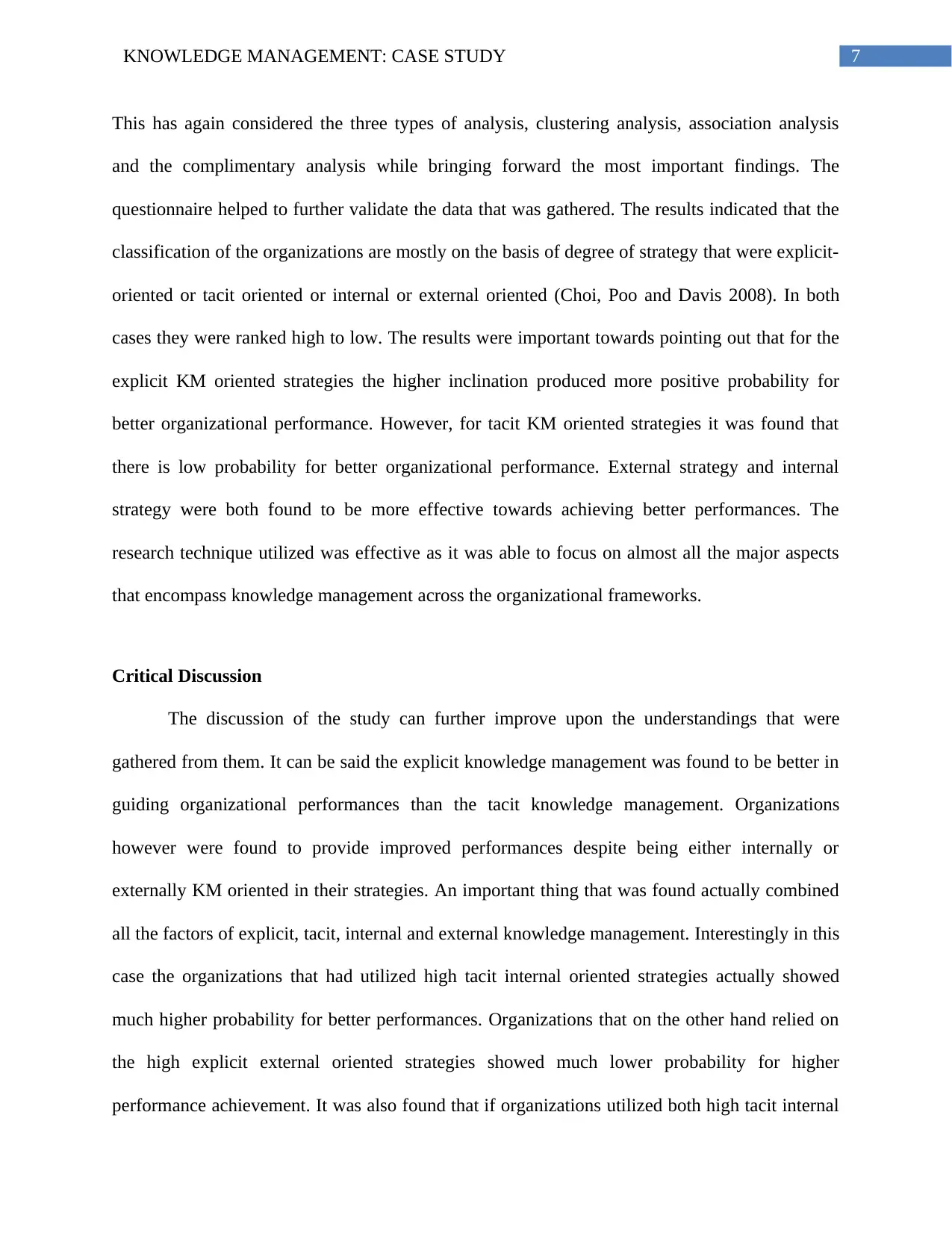
7KNOWLEDGE MANAGEMENT: CASE STUDY
This has again considered the three types of analysis, clustering analysis, association analysis
and the complimentary analysis while bringing forward the most important findings. The
questionnaire helped to further validate the data that was gathered. The results indicated that the
classification of the organizations are mostly on the basis of degree of strategy that were explicit-
oriented or tacit oriented or internal or external oriented (Choi, Poo and Davis 2008). In both
cases they were ranked high to low. The results were important towards pointing out that for the
explicit KM oriented strategies the higher inclination produced more positive probability for
better organizational performance. However, for tacit KM oriented strategies it was found that
there is low probability for better organizational performance. External strategy and internal
strategy were both found to be more effective towards achieving better performances. The
research technique utilized was effective as it was able to focus on almost all the major aspects
that encompass knowledge management across the organizational frameworks.
Critical Discussion
The discussion of the study can further improve upon the understandings that were
gathered from them. It can be said the explicit knowledge management was found to be better in
guiding organizational performances than the tacit knowledge management. Organizations
however were found to provide improved performances despite being either internally or
externally KM oriented in their strategies. An important thing that was found actually combined
all the factors of explicit, tacit, internal and external knowledge management. Interestingly in this
case the organizations that had utilized high tacit internal oriented strategies actually showed
much higher probability for better performances. Organizations that on the other hand relied on
the high explicit external oriented strategies showed much lower probability for higher
performance achievement. It was also found that if organizations utilized both high tacit internal
This has again considered the three types of analysis, clustering analysis, association analysis
and the complimentary analysis while bringing forward the most important findings. The
questionnaire helped to further validate the data that was gathered. The results indicated that the
classification of the organizations are mostly on the basis of degree of strategy that were explicit-
oriented or tacit oriented or internal or external oriented (Choi, Poo and Davis 2008). In both
cases they were ranked high to low. The results were important towards pointing out that for the
explicit KM oriented strategies the higher inclination produced more positive probability for
better organizational performance. However, for tacit KM oriented strategies it was found that
there is low probability for better organizational performance. External strategy and internal
strategy were both found to be more effective towards achieving better performances. The
research technique utilized was effective as it was able to focus on almost all the major aspects
that encompass knowledge management across the organizational frameworks.
Critical Discussion
The discussion of the study can further improve upon the understandings that were
gathered from them. It can be said the explicit knowledge management was found to be better in
guiding organizational performances than the tacit knowledge management. Organizations
however were found to provide improved performances despite being either internally or
externally KM oriented in their strategies. An important thing that was found actually combined
all the factors of explicit, tacit, internal and external knowledge management. Interestingly in this
case the organizations that had utilized high tacit internal oriented strategies actually showed
much higher probability for better performances. Organizations that on the other hand relied on
the high explicit external oriented strategies showed much lower probability for higher
performance achievement. It was also found that if organizations utilized both high tacit internal
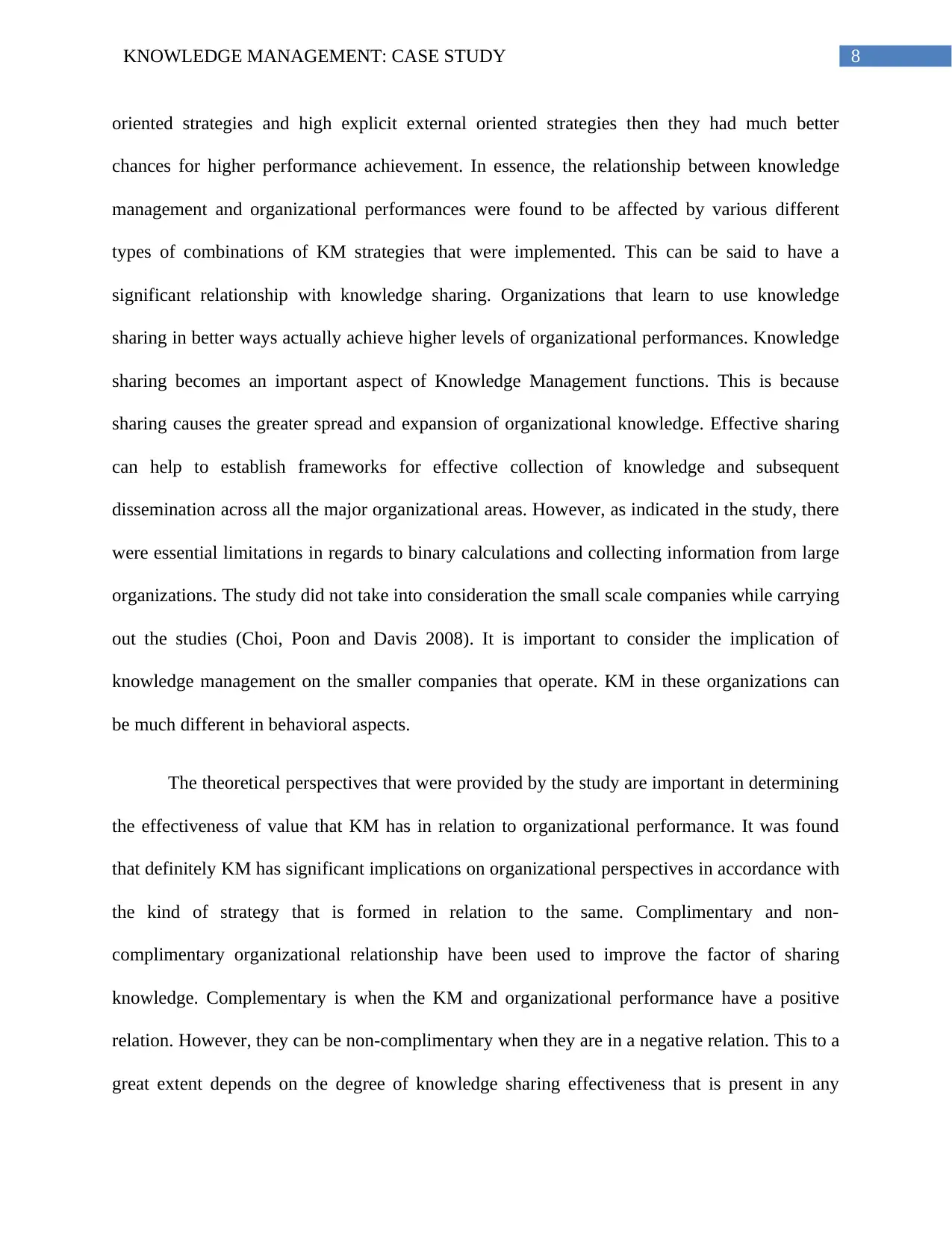
8KNOWLEDGE MANAGEMENT: CASE STUDY
oriented strategies and high explicit external oriented strategies then they had much better
chances for higher performance achievement. In essence, the relationship between knowledge
management and organizational performances were found to be affected by various different
types of combinations of KM strategies that were implemented. This can be said to have a
significant relationship with knowledge sharing. Organizations that learn to use knowledge
sharing in better ways actually achieve higher levels of organizational performances. Knowledge
sharing becomes an important aspect of Knowledge Management functions. This is because
sharing causes the greater spread and expansion of organizational knowledge. Effective sharing
can help to establish frameworks for effective collection of knowledge and subsequent
dissemination across all the major organizational areas. However, as indicated in the study, there
were essential limitations in regards to binary calculations and collecting information from large
organizations. The study did not take into consideration the small scale companies while carrying
out the studies (Choi, Poon and Davis 2008). It is important to consider the implication of
knowledge management on the smaller companies that operate. KM in these organizations can
be much different in behavioral aspects.
The theoretical perspectives that were provided by the study are important in determining
the effectiveness of value that KM has in relation to organizational performance. It was found
that definitely KM has significant implications on organizational perspectives in accordance with
the kind of strategy that is formed in relation to the same. Complimentary and non-
complimentary organizational relationship have been used to improve the factor of sharing
knowledge. Complementary is when the KM and organizational performance have a positive
relation. However, they can be non-complimentary when they are in a negative relation. This to a
great extent depends on the degree of knowledge sharing effectiveness that is present in any
oriented strategies and high explicit external oriented strategies then they had much better
chances for higher performance achievement. In essence, the relationship between knowledge
management and organizational performances were found to be affected by various different
types of combinations of KM strategies that were implemented. This can be said to have a
significant relationship with knowledge sharing. Organizations that learn to use knowledge
sharing in better ways actually achieve higher levels of organizational performances. Knowledge
sharing becomes an important aspect of Knowledge Management functions. This is because
sharing causes the greater spread and expansion of organizational knowledge. Effective sharing
can help to establish frameworks for effective collection of knowledge and subsequent
dissemination across all the major organizational areas. However, as indicated in the study, there
were essential limitations in regards to binary calculations and collecting information from large
organizations. The study did not take into consideration the small scale companies while carrying
out the studies (Choi, Poon and Davis 2008). It is important to consider the implication of
knowledge management on the smaller companies that operate. KM in these organizations can
be much different in behavioral aspects.
The theoretical perspectives that were provided by the study are important in determining
the effectiveness of value that KM has in relation to organizational performance. It was found
that definitely KM has significant implications on organizational perspectives in accordance with
the kind of strategy that is formed in relation to the same. Complimentary and non-
complimentary organizational relationship have been used to improve the factor of sharing
knowledge. Complementary is when the KM and organizational performance have a positive
relation. However, they can be non-complimentary when they are in a negative relation. This to a
great extent depends on the degree of knowledge sharing effectiveness that is present in any
⊘ This is a preview!⊘
Do you want full access?
Subscribe today to unlock all pages.

Trusted by 1+ million students worldwide

9KNOWLEDGE MANAGEMENT: CASE STUDY
organization. Hence, it can be seen that through the study it was clarified that the strategies
through which information is shared in organizations actually provide the developmental paths
concerning the organizational performances. KM cannot be undermined due to organizational
strengths. The study reveals that if KM is insufficiently managed it can cause issues that can
affect organizational performances and growth subsequently. KM strategies essentially depend
on the techniques of sharing knowledge as without sharing knowledge cannot be communicated
between the various departments. Hence, the findings suggest that KM strategies need to be
optimized through the consideration of both forms of organizational knowledge.
Conclusion
The implication point to the fact that organizations need to pay attention towards
implementing effective strategies for knowledge management. It is important to understand that
the various companies operating within various organizational environments need to form better
strategies to create knowledge management frameworks that facilitate the learning to share
knowledge. How to share knowledge is an essential aspect of knowledge management.
Subsequently, this can be used towards generating better understanding among the various
organizational levels. Distinction should be made between the complimentary and the non-
complimentary aspects of Knowledge Management in organizations. It is important that
companies function as per the knowledge that they have essentially gathered and form effective
strategies to use the same to from better relationships between KM and organizational
performance. The relationship between the two is much important.
organization. Hence, it can be seen that through the study it was clarified that the strategies
through which information is shared in organizations actually provide the developmental paths
concerning the organizational performances. KM cannot be undermined due to organizational
strengths. The study reveals that if KM is insufficiently managed it can cause issues that can
affect organizational performances and growth subsequently. KM strategies essentially depend
on the techniques of sharing knowledge as without sharing knowledge cannot be communicated
between the various departments. Hence, the findings suggest that KM strategies need to be
optimized through the consideration of both forms of organizational knowledge.
Conclusion
The implication point to the fact that organizations need to pay attention towards
implementing effective strategies for knowledge management. It is important to understand that
the various companies operating within various organizational environments need to form better
strategies to create knowledge management frameworks that facilitate the learning to share
knowledge. How to share knowledge is an essential aspect of knowledge management.
Subsequently, this can be used towards generating better understanding among the various
organizational levels. Distinction should be made between the complimentary and the non-
complimentary aspects of Knowledge Management in organizations. It is important that
companies function as per the knowledge that they have essentially gathered and form effective
strategies to use the same to from better relationships between KM and organizational
performance. The relationship between the two is much important.
Paraphrase This Document
Need a fresh take? Get an instant paraphrase of this document with our AI Paraphraser
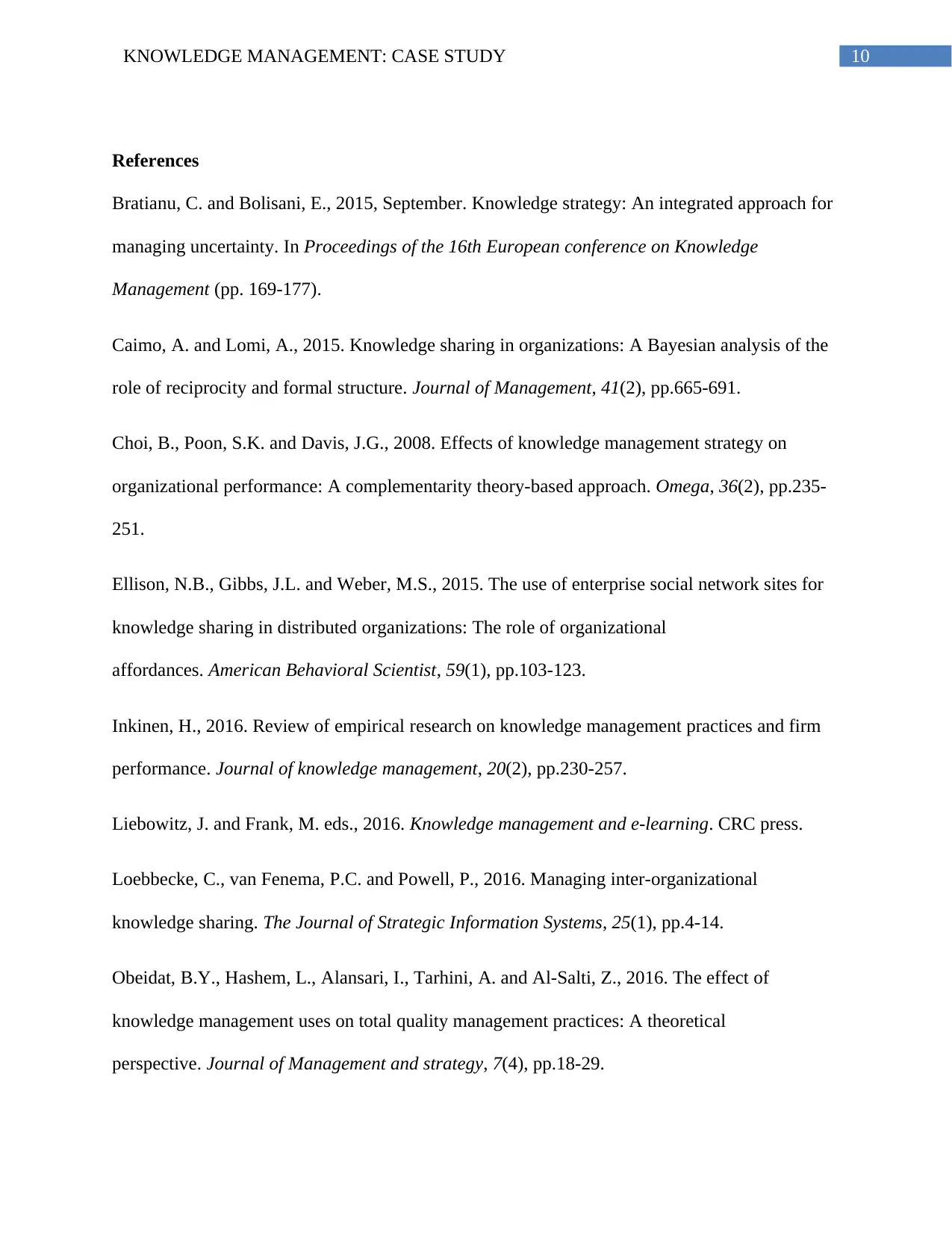
10KNOWLEDGE MANAGEMENT: CASE STUDY
References
Bratianu, C. and Bolisani, E., 2015, September. Knowledge strategy: An integrated approach for
managing uncertainty. In Proceedings of the 16th European conference on Knowledge
Management (pp. 169-177).
Caimo, A. and Lomi, A., 2015. Knowledge sharing in organizations: A Bayesian analysis of the
role of reciprocity and formal structure. Journal of Management, 41(2), pp.665-691.
Choi, B., Poon, S.K. and Davis, J.G., 2008. Effects of knowledge management strategy on
organizational performance: A complementarity theory-based approach. Omega, 36(2), pp.235-
251.
Ellison, N.B., Gibbs, J.L. and Weber, M.S., 2015. The use of enterprise social network sites for
knowledge sharing in distributed organizations: The role of organizational
affordances. American Behavioral Scientist, 59(1), pp.103-123.
Inkinen, H., 2016. Review of empirical research on knowledge management practices and firm
performance. Journal of knowledge management, 20(2), pp.230-257.
Liebowitz, J. and Frank, M. eds., 2016. Knowledge management and e-learning. CRC press.
Loebbecke, C., van Fenema, P.C. and Powell, P., 2016. Managing inter-organizational
knowledge sharing. The Journal of Strategic Information Systems, 25(1), pp.4-14.
Obeidat, B.Y., Hashem, L., Alansari, I., Tarhini, A. and Al-Salti, Z., 2016. The effect of
knowledge management uses on total quality management practices: A theoretical
perspective. Journal of Management and strategy, 7(4), pp.18-29.
References
Bratianu, C. and Bolisani, E., 2015, September. Knowledge strategy: An integrated approach for
managing uncertainty. In Proceedings of the 16th European conference on Knowledge
Management (pp. 169-177).
Caimo, A. and Lomi, A., 2015. Knowledge sharing in organizations: A Bayesian analysis of the
role of reciprocity and formal structure. Journal of Management, 41(2), pp.665-691.
Choi, B., Poon, S.K. and Davis, J.G., 2008. Effects of knowledge management strategy on
organizational performance: A complementarity theory-based approach. Omega, 36(2), pp.235-
251.
Ellison, N.B., Gibbs, J.L. and Weber, M.S., 2015. The use of enterprise social network sites for
knowledge sharing in distributed organizations: The role of organizational
affordances. American Behavioral Scientist, 59(1), pp.103-123.
Inkinen, H., 2016. Review of empirical research on knowledge management practices and firm
performance. Journal of knowledge management, 20(2), pp.230-257.
Liebowitz, J. and Frank, M. eds., 2016. Knowledge management and e-learning. CRC press.
Loebbecke, C., van Fenema, P.C. and Powell, P., 2016. Managing inter-organizational
knowledge sharing. The Journal of Strategic Information Systems, 25(1), pp.4-14.
Obeidat, B.Y., Hashem, L., Alansari, I., Tarhini, A. and Al-Salti, Z., 2016. The effect of
knowledge management uses on total quality management practices: A theoretical
perspective. Journal of Management and strategy, 7(4), pp.18-29.
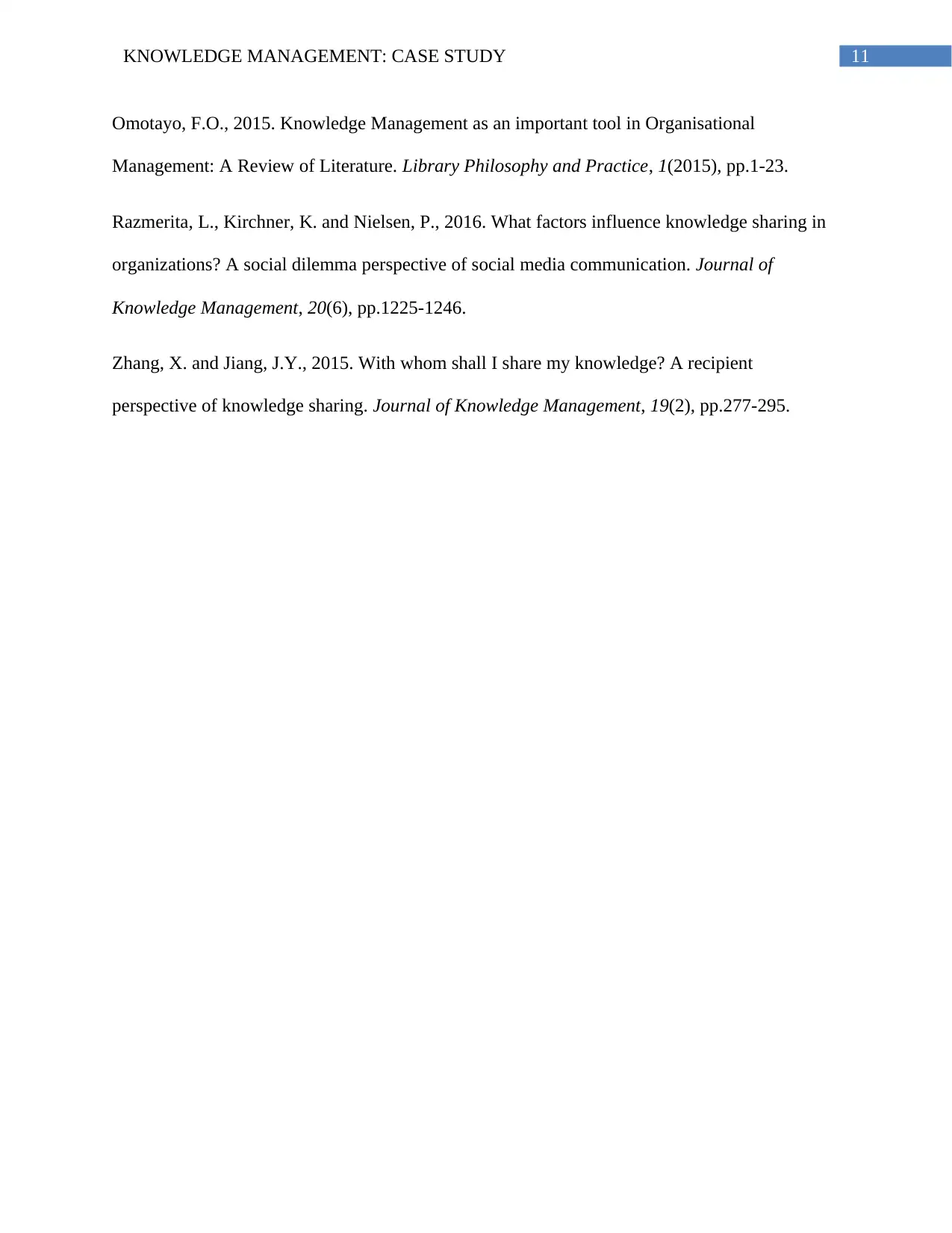
11KNOWLEDGE MANAGEMENT: CASE STUDY
Omotayo, F.O., 2015. Knowledge Management as an important tool in Organisational
Management: A Review of Literature. Library Philosophy and Practice, 1(2015), pp.1-23.
Razmerita, L., Kirchner, K. and Nielsen, P., 2016. What factors influence knowledge sharing in
organizations? A social dilemma perspective of social media communication. Journal of
Knowledge Management, 20(6), pp.1225-1246.
Zhang, X. and Jiang, J.Y., 2015. With whom shall I share my knowledge? A recipient
perspective of knowledge sharing. Journal of Knowledge Management, 19(2), pp.277-295.
Omotayo, F.O., 2015. Knowledge Management as an important tool in Organisational
Management: A Review of Literature. Library Philosophy and Practice, 1(2015), pp.1-23.
Razmerita, L., Kirchner, K. and Nielsen, P., 2016. What factors influence knowledge sharing in
organizations? A social dilemma perspective of social media communication. Journal of
Knowledge Management, 20(6), pp.1225-1246.
Zhang, X. and Jiang, J.Y., 2015. With whom shall I share my knowledge? A recipient
perspective of knowledge sharing. Journal of Knowledge Management, 19(2), pp.277-295.
⊘ This is a preview!⊘
Do you want full access?
Subscribe today to unlock all pages.

Trusted by 1+ million students worldwide
1 out of 12
Related Documents
Your All-in-One AI-Powered Toolkit for Academic Success.
+13062052269
info@desklib.com
Available 24*7 on WhatsApp / Email
![[object Object]](/_next/static/media/star-bottom.7253800d.svg)
Unlock your academic potential
Copyright © 2020–2025 A2Z Services. All Rights Reserved. Developed and managed by ZUCOL.





